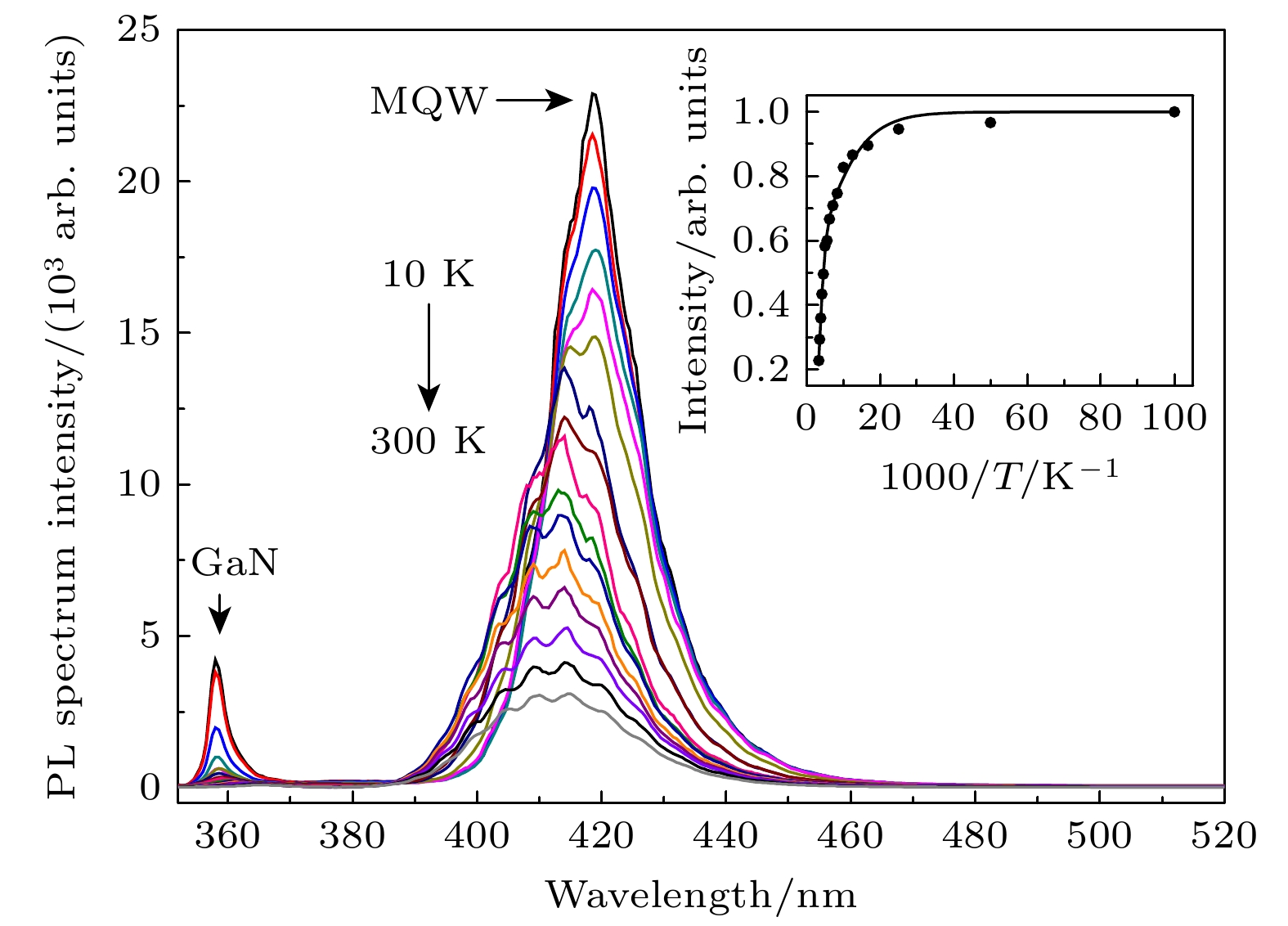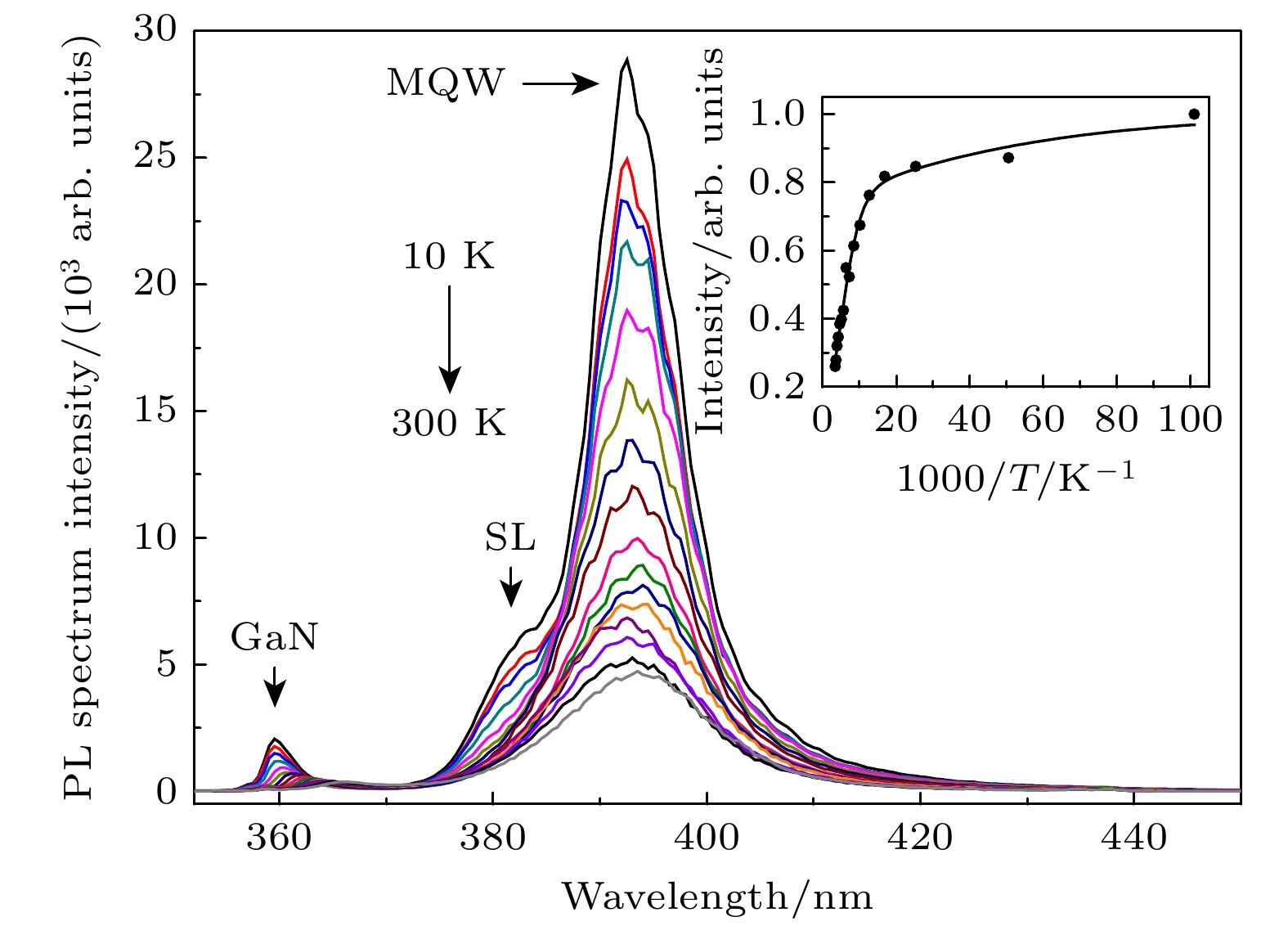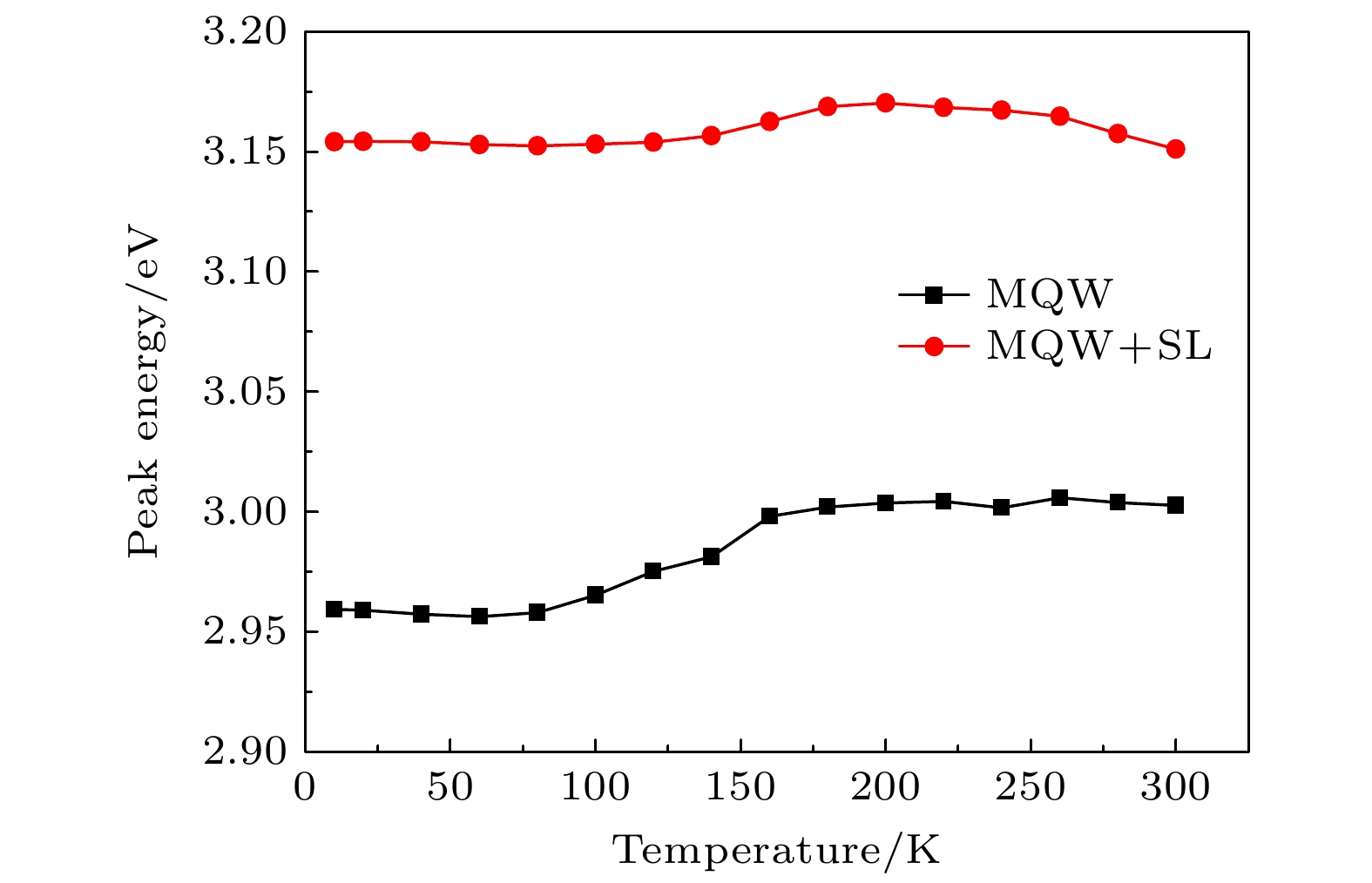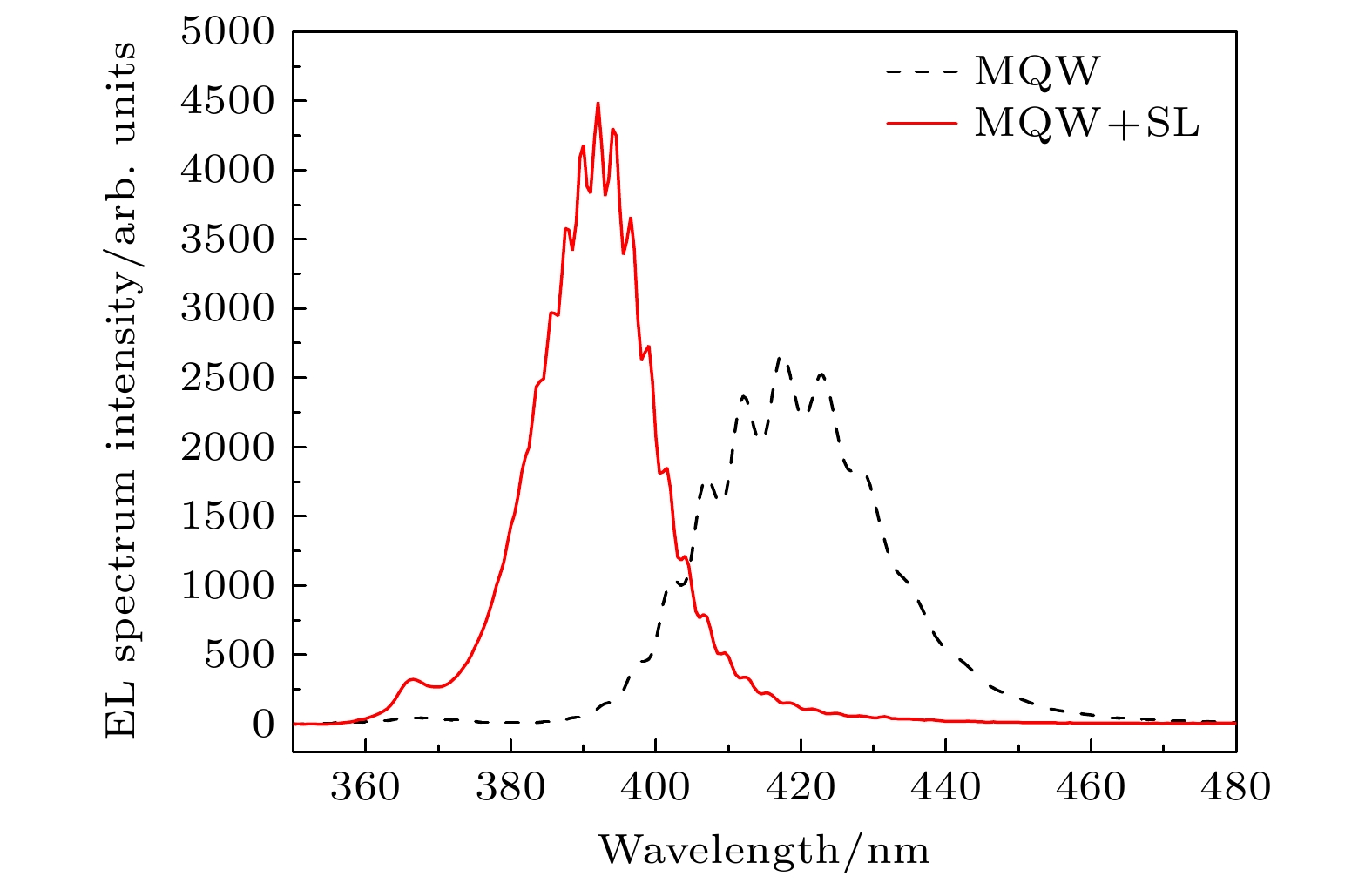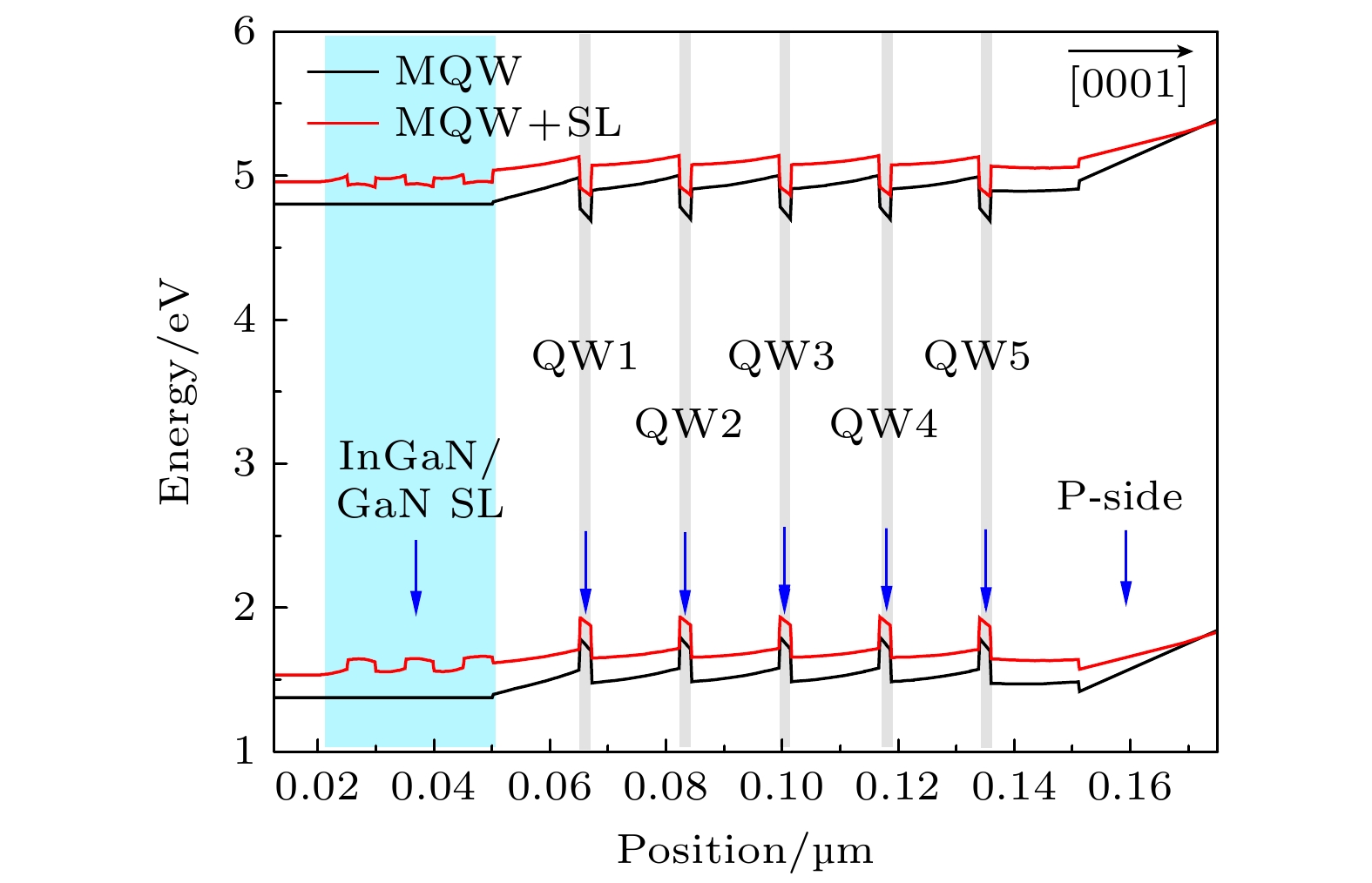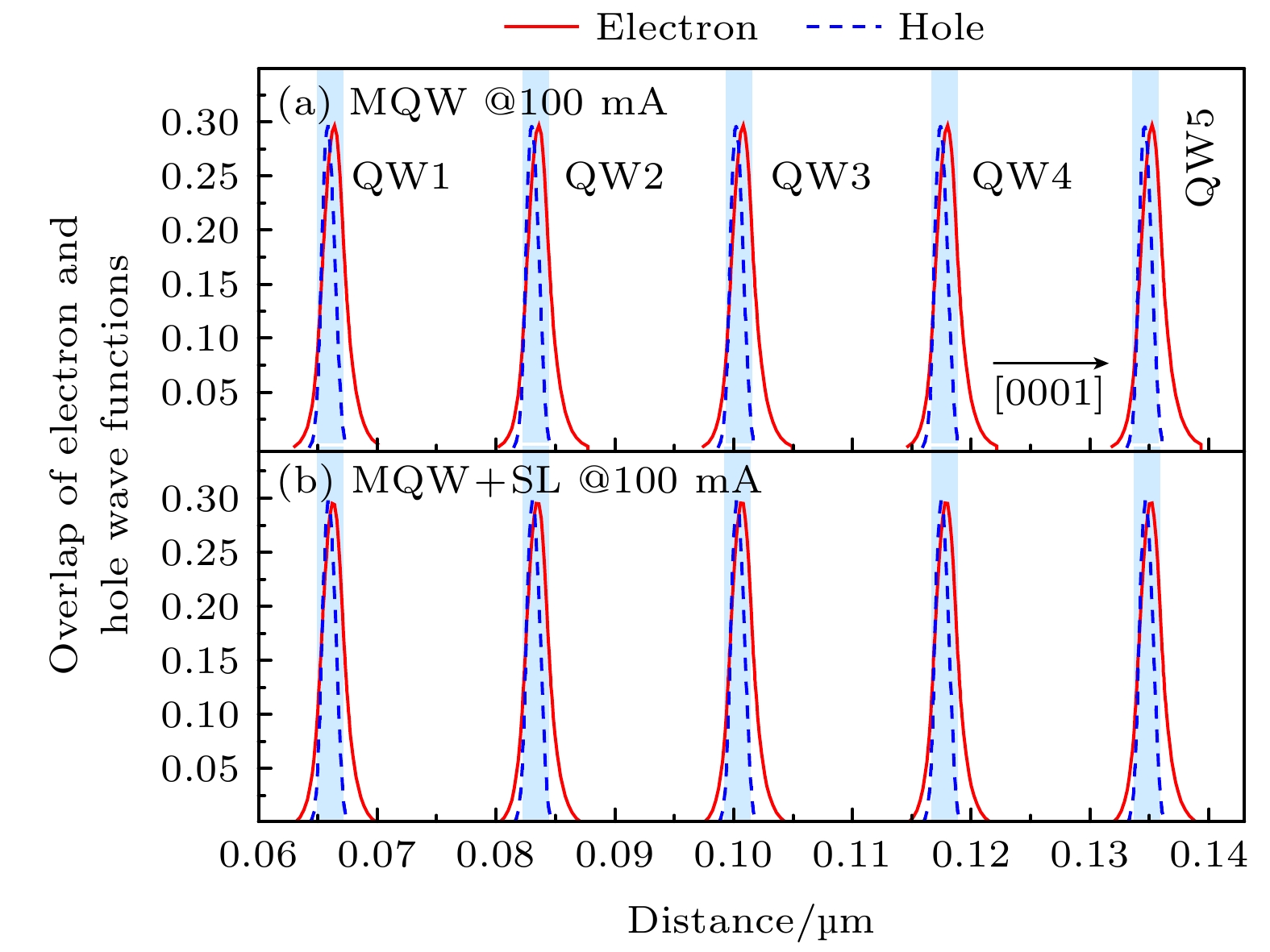-
在InGaN/GaN异质结构量子阱内存在巨大的压电极化场, 这严重地削弱了量子阱的发光效率. 为了减弱量子阱内的压电极化场, 通常引入应变调制插入层提升器件的发光性能. 为了研究InGaN/GaN超晶格的应变调制效果和机理, 实验设计制备了具有n型InGaN/GaN超晶格插入层的外延结构及其对照样品. 变温光致发光谱测试表明引入n型InGaN/GaN超晶格插入层的样品发光波长更短且内量子效率提升, 相应的电致发光谱积分强度也显著增加且半宽减小, 说明引入超晶格应变插入层可以在一定程度上抑制影响发光效率的量子限制Stark效应. 理论计算结果表明: 在生长有源区量子阱前引入超晶格应变层, 可以削弱有源区量子阱内极化内建电场, 减弱有源区量子阱能带倾斜, 增加电子空穴波函数交叠, 提高发射几率, 缩短辐射复合寿命, 有利于辐射复合与非辐射复合的竞争, 实现更高的复合效率, 从而提高发光强度. 本文从实验和理论两方面验证了超晶格应变调制插入层可以有效改善器件性能, 为器件的结构设计优化指明方向.The strong piezoelectric field in InGaN/GaN heterostructure quantum wells severely reduces the light emission efficiency of multiple quantum well (MQW) structures. To address this issue, a strain modulation interlayer is commonly used to mitigate the piezoelectric polarization field and improve the luminescence performance of the devices. To investigate the influence and mechanism of strain modulation in the InGaN/GaN superlattice (SL), epitaxial wafers with an n-type InGaN/GaN SL interlayer sample, and their corresponding control samples are prepared. The measured temperature-dependent photoluminescence (PL) spectra of the epitaxial wafers, show that the introduction of an SL interlayer leads to a shorter-wavelength emission and enhancement of internal quantum efficiency. As the temperature increases, a blue shift of the PL peak is observed. However, for the sample with an SL interlayer, the blue shift of the PL peak with temperature increasing is relatively small. Electroluminescence (EL) experiments indicate that the introduction of an SL interlayer significantly increases the integrated intensity of the EL peak and reduces its full width at half maximum. These phenomena collectively indicate that the incorporation of a superlattice interlayer can partly suppress the quantum-confined Stark effect (QCSE) that affects the light emission efficiency. Theoretical calculations show that the introduction of a superlattice strain layer before growing an active multiple quantum well can weaken the polarization-induced built-in electric field in the active quantum well, reduce the tilt of the energy band in the multiple quantum well active region, increase the overlap of electron and hole wave functions, enhance the emission probability, shorten the radiative recombination lifetime, and promote competition between radiative recombination and non-radiative recombination, thereby achieving higher recombination efficiency and improving light emission intensity. This study provides experimental and theoretical evidence that the strain modulation SL interlayer can effectively improve the device performance and offer guidance for optimizing the structural design of devices.
-
Keywords:
- GaN /
- multiple quantum well /
- superlattice /
- strain modulation
[1] Han D, Kim J, Shin D, Shim J 2023 Opt. Express 31 15779
 Google Scholar
Google Scholar
[2] Jeong H, Jeong H, Oh H, Hong C, Suh E, Lerondel G, Jeong M 2015 Sci. Rep. 5 9373
 Google Scholar
Google Scholar
[3] Zhou S, Wan Z, Lei Y, Tang B, Tao G, Du P, Zhao X 2022 Opt. Lett. 47 1291
 Google Scholar
Google Scholar
[4] Wu Y, Xiao Y, Navid I, Sun K, Malhotra Y, Wang P, Wang D, Xu Y, Pandey A, Reddeppa M, Shin W, Liu J, Min J, Mi Z 2022 Light Sci. Appl. 11 294
 Google Scholar
Google Scholar
[5] Das S, Lenka T, Talukdar F, Sadaf S, Velpula R, Nguyen H 2022 Appl. Opt. 61 8951
 Google Scholar
Google Scholar
[6] Cho L, Lee B, Lee K, Kim J, Ryu M 2021 J. Nanosci. Nanotechnol. 21 5648
 Google Scholar
Google Scholar
[7] Hu H, Zhou S, Wan H, Liu X, Li N, Xu H 2019 Sci. Rep. 9 3447
 Google Scholar
Google Scholar
[8] Li X, Liu J, Su X, Huang S, Tian A, Zhou W, Jiang L, Ikeda M, Yang H 2021 Materials (Basel, Switzerland) 14 1877
 Google Scholar
Google Scholar
[9] Cai J X, Sun H Q, Zheng H, Zhang P J, Guo Z Y 2014 Chin. Phys. B 23 58502
 Google Scholar
Google Scholar
[10] 邢艳辉, 邓军, 韩军, 李建军, 沈光池 2009 物理学报 58 590
 Google Scholar
Google Scholar
Xing Y H, Deng J, Han J, Li J J, Shen G C 2009 Acta Phys. Sin. 58 590
 Google Scholar
Google Scholar
[11] Shi J L, Shin Y C, Kim K C, Kim E H, Yun M S, Moon Y, Hwang S M, Kim T G 2008 J. Cryst. Growth 311 103
 Google Scholar
Google Scholar
[12] 齐维靖, 张萌, 潘拴, 王小兰, 张建立, 江风益 2016 物理学报 65 077801
 Google Scholar
Google Scholar
Qi W J, Zhang M, Pan S, Wang X L, Zhang J L, Jiang F Y 2016 Acta Phys. Sin. 65 077801
 Google Scholar
Google Scholar
[13] Cui S, Tao G, Gong L, Zhao X, Zhou S 2022 Materials (Basel, Switzerland) 15 8649
 Google Scholar
Google Scholar
[14] Liu L, Wang L, Li D, Liu N Y, Li L, Cao W Y, Yang W, Wan C H, Chen W H, Du W M, Hu X D, Feng Z C 2011 J. Appl. Phys. 109 073106
 Google Scholar
Google Scholar
[15] Chen C, Hsieh C, Liao C, Chung W, Chen H, Cao W, Chang W, Chen H, Yao Y, Ting S, Kiang Y, Yang C, Hu X 2012 Opt. Express 20 11321
 Google Scholar
Google Scholar
[16] Kuroda T, Tackeuchi A, Sota T 2000 Appl. Phys. Lett. 76 3753
 Google Scholar
Google Scholar
[17] Akasaka T, Gotoh H, Saito T, Makimoto T 2004 Appl. Phys. Lett. 85 3089
 Google Scholar
Google Scholar
[18] Kumano H, Hoshi K, Tanaka S, Suemune I, Shen X Q, Riblet P, Ramvall P, Aoyagi Y 1999 Appl. Phys. Lett. 75 2879
 Google Scholar
Google Scholar
[19] Ridley B K, Schaff W J, Eastman L F 2003 J. Appl. Phys. 94 3972
 Google Scholar
Google Scholar
[20] Sze S M, Ng K K 1981 Physics of Semiconductor Devices (New York: Wiley) p45
[21] Hsu L, Walukiewicz W 1998 Appl. Phys. Lett. 73 339
 Google Scholar
Google Scholar
[22] Fiorentini V, Bernardini F, Ambacher O 2002 Appl. Phys. Lett. 80 1204
 Google Scholar
Google Scholar
[23] Chuang S L 1995 Physics of Optoelectronic Devices (New York: Wiley) p560
[24] Zhang H, Miller E J, Yu E T, Poblenz C, Speck J S 2004 Appl. Phys. Lett. 84 4644
 Google Scholar
Google Scholar
[25] Renner F, Kiesel P, Döhler G H, Kneissl M, Van de Walle C G, Johnson N M 2002 Appl. Phys. Lett. 81 490
 Google Scholar
Google Scholar
[26] Braun W, Dowd P, Guo C Z, Chen S L, Ryu C M, Koelle U, Johnson S R, Zhang Y H, Tomm J W, Elsässer T, Smith D J 2000 J. Appl. Phys. 88 3004
 Google Scholar
Google Scholar
-
表 1 拟合参数α, β, EA1, EA2及内量子效率
Table 1. Fitting Parameters of α, β, EA1, and EA2 together with the internal quantum efficiency.
Sample IQE/% $ \alpha $ $ \beta $ $ {E_{{\text{A1}}}}{\text{/meV}} $ $ {E_{{\text{A2}}}}{\text{/meV}} $ MQW 22 0.33 9.28 5.36 47.80 MQW+SL 26 0.34 8.23 2.05 33.37 表 2 量子阱中电场强度和波函数交叠积分模拟结果
Table 2. Simulation results of the electric field and wave function overlaps in each quantum well.
MQW Electric field E1/(kV⋅cm–1) Overlap/% MQW+SL Electric field E2/(kV⋅cm–1) Overlap/% QW1 442.5 83.9 QW1 396.7 89.1 QW2 467.1 82.7 QW2 410.0 88.7 QW3 473.0 82.6 QW3 414.3 88.7 QW4 475.8 82.5 QW4 418.1 88.6 QW5 484.2 81.2 QW5 425.6 87.8 -
[1] Han D, Kim J, Shin D, Shim J 2023 Opt. Express 31 15779
 Google Scholar
Google Scholar
[2] Jeong H, Jeong H, Oh H, Hong C, Suh E, Lerondel G, Jeong M 2015 Sci. Rep. 5 9373
 Google Scholar
Google Scholar
[3] Zhou S, Wan Z, Lei Y, Tang B, Tao G, Du P, Zhao X 2022 Opt. Lett. 47 1291
 Google Scholar
Google Scholar
[4] Wu Y, Xiao Y, Navid I, Sun K, Malhotra Y, Wang P, Wang D, Xu Y, Pandey A, Reddeppa M, Shin W, Liu J, Min J, Mi Z 2022 Light Sci. Appl. 11 294
 Google Scholar
Google Scholar
[5] Das S, Lenka T, Talukdar F, Sadaf S, Velpula R, Nguyen H 2022 Appl. Opt. 61 8951
 Google Scholar
Google Scholar
[6] Cho L, Lee B, Lee K, Kim J, Ryu M 2021 J. Nanosci. Nanotechnol. 21 5648
 Google Scholar
Google Scholar
[7] Hu H, Zhou S, Wan H, Liu X, Li N, Xu H 2019 Sci. Rep. 9 3447
 Google Scholar
Google Scholar
[8] Li X, Liu J, Su X, Huang S, Tian A, Zhou W, Jiang L, Ikeda M, Yang H 2021 Materials (Basel, Switzerland) 14 1877
 Google Scholar
Google Scholar
[9] Cai J X, Sun H Q, Zheng H, Zhang P J, Guo Z Y 2014 Chin. Phys. B 23 58502
 Google Scholar
Google Scholar
[10] 邢艳辉, 邓军, 韩军, 李建军, 沈光池 2009 物理学报 58 590
 Google Scholar
Google Scholar
Xing Y H, Deng J, Han J, Li J J, Shen G C 2009 Acta Phys. Sin. 58 590
 Google Scholar
Google Scholar
[11] Shi J L, Shin Y C, Kim K C, Kim E H, Yun M S, Moon Y, Hwang S M, Kim T G 2008 J. Cryst. Growth 311 103
 Google Scholar
Google Scholar
[12] 齐维靖, 张萌, 潘拴, 王小兰, 张建立, 江风益 2016 物理学报 65 077801
 Google Scholar
Google Scholar
Qi W J, Zhang M, Pan S, Wang X L, Zhang J L, Jiang F Y 2016 Acta Phys. Sin. 65 077801
 Google Scholar
Google Scholar
[13] Cui S, Tao G, Gong L, Zhao X, Zhou S 2022 Materials (Basel, Switzerland) 15 8649
 Google Scholar
Google Scholar
[14] Liu L, Wang L, Li D, Liu N Y, Li L, Cao W Y, Yang W, Wan C H, Chen W H, Du W M, Hu X D, Feng Z C 2011 J. Appl. Phys. 109 073106
 Google Scholar
Google Scholar
[15] Chen C, Hsieh C, Liao C, Chung W, Chen H, Cao W, Chang W, Chen H, Yao Y, Ting S, Kiang Y, Yang C, Hu X 2012 Opt. Express 20 11321
 Google Scholar
Google Scholar
[16] Kuroda T, Tackeuchi A, Sota T 2000 Appl. Phys. Lett. 76 3753
 Google Scholar
Google Scholar
[17] Akasaka T, Gotoh H, Saito T, Makimoto T 2004 Appl. Phys. Lett. 85 3089
 Google Scholar
Google Scholar
[18] Kumano H, Hoshi K, Tanaka S, Suemune I, Shen X Q, Riblet P, Ramvall P, Aoyagi Y 1999 Appl. Phys. Lett. 75 2879
 Google Scholar
Google Scholar
[19] Ridley B K, Schaff W J, Eastman L F 2003 J. Appl. Phys. 94 3972
 Google Scholar
Google Scholar
[20] Sze S M, Ng K K 1981 Physics of Semiconductor Devices (New York: Wiley) p45
[21] Hsu L, Walukiewicz W 1998 Appl. Phys. Lett. 73 339
 Google Scholar
Google Scholar
[22] Fiorentini V, Bernardini F, Ambacher O 2002 Appl. Phys. Lett. 80 1204
 Google Scholar
Google Scholar
[23] Chuang S L 1995 Physics of Optoelectronic Devices (New York: Wiley) p560
[24] Zhang H, Miller E J, Yu E T, Poblenz C, Speck J S 2004 Appl. Phys. Lett. 84 4644
 Google Scholar
Google Scholar
[25] Renner F, Kiesel P, Döhler G H, Kneissl M, Van de Walle C G, Johnson N M 2002 Appl. Phys. Lett. 81 490
 Google Scholar
Google Scholar
[26] Braun W, Dowd P, Guo C Z, Chen S L, Ryu C M, Koelle U, Johnson S R, Zhang Y H, Tomm J W, Elsässer T, Smith D J 2000 J. Appl. Phys. 88 3004
 Google Scholar
Google Scholar
计量
- 文章访问数: 9062
- PDF下载量: 102
- 被引次数: 0













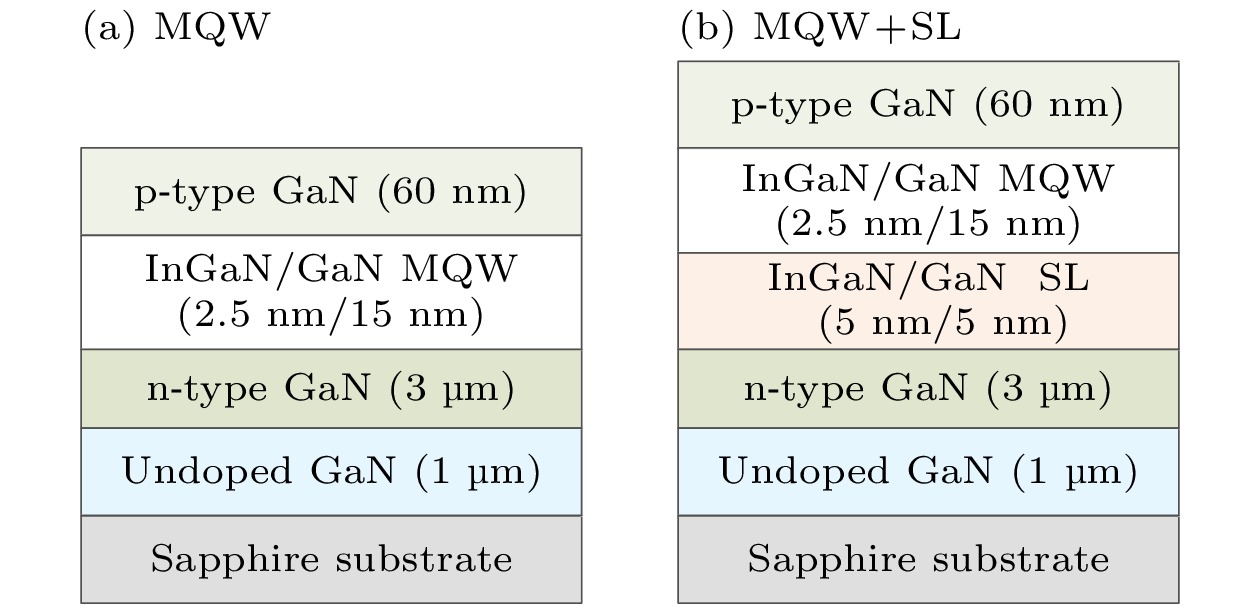
 下载:
下载:
